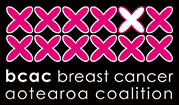Latest News

A breast cancer charity says a new report that identifies a multi-million dollar funding gap for medicines is a damning indictment of a failing system and an urgent wake-up call for change.
The report by the New Zealand Institute of Economic Research (NZIER) has found that medicines funding has fallen in real terms every year since 2007 to the point where there is now an investment gap of more than $680 million.
The NZIER says this is how much extra money would be needed simply to bring the medicines budget back to the level it was in 2007 in real terms.
The Breast Cancer Aotearoa Coalition (BCAC) chair, Libby Burgess, says the report paints a shameful picture of medicines funding in New Zealand.

Researchers have discovered that women with breast cancer have far less of a particular bacterial species in their breast tissue than healthy women.
The new study, published in the journal Oncotarget, found that breast tissue in women with breast cancer contained far less Methylobacterium.
The finding could offer a new perspective in the battle against breast cancer and is yet another advance in understanding the role bacteria in the body play in human health. These bacteria are known as the microbiome and have been found to influence many diseases. Much research has been done on the gut microbiome in the digestive tract.

Ten-year results from a major breast cancer clinical trial suggest that routinely removing the axillary lymph nodes during lumpectomy to remove early-stage breast cancer may not be necessary.
The study was published in the journal JAMA and examined nearly 900 women diagnosed with early-stage breast cancer to find out if axillary node dissection lead to better long-term outcomes.
The axillary lymph nodes are the lymph nodes under the arm. Surgically removing those lymph nodes is called axillary lymph node dissection and is often done if a sentinel node biopsy indicates the cancer has spread beyond the breast.

The Breast Cancer Aotearoa Coalition (BCAC) is thrilled to see a proposed extension of the upper age for free breast screening from 69 to 74-years-old in the Labour-New Zealand First coalition agreement.
The move is one of the key details for health outlined in the coalition agreement. At the moment, BreastScreen Aotearoa only offers free breast screening to women between the ages of 45 and 69.
BCAC chair, Libby Burgess, says she’s over-the-moon to see a concrete plan to extend screening to women older than 69.
“We’ve been lobbying for the upper age limit for free screening to be increased for years and it’s brilliant to see this new Government taking immediate action on this matter.

Pinc & STEEL PaddleOn is a stand-up paddle (SUP) rehabilitation programme, for men and women recovering from all types of cancer.
Delivered over five weeks by certified Pinc or STEEL cancer rehabilitation physiotherapists, PaddleOn has been specifically designed to introduce the components of stand-up paddling in a safe, fun small group environment on the water.
It is divided into eight modules to improve balance, core strength, posture, upper body strength, flexibility and fitness.
Participants need to have completed primary cancer treatment (surgery/chemotherapy/radiotherapy) before starting the programme (you may require a Pinc/STEEL physiotherapist assessment first).

Researchers have reviewed the evidence on early menopause in breast cancer patients and have come up with a series of recommendations to safely manage this side-effect.
The recommendations are published in The Journal of Clinical Endocrinology and Metabolism and are the result of a review of a number of clinical trials, observational studies and guidelines.
Chemotherapy treatment can often result in early menopause for women with breast cancer, while hormone therapy, such as tamoxifen and aromatase inhibitors, can also result in early menopause or make menopausal symptoms worse.
Menopausal symptoms can include:

A breakthrough breast cancer drug can now be used in New Zealand, but the Breast Cancer Aotearoa Coalition (BCAC) is calling for Ibrance (palbociclib) to be publicly funded immediately.
MedSafe NZ has just approved the use of Ibrance for those with advanced hormone receptor positive and HER2-negative breast cancer, but it’s only available to those who can pay for it.
Ibrance is an innovative new drug and preliminary clinical evidence for it was so strong that the United States Food and Drug Administration fast-tracked its use in that country.
BCAC chairperson Libby Burgess says hundreds of women could potentially benefit from Ibrance now that it is available in New Zealand.

A new study has found that annual mammograms beginning at age 40 prevent the greatest number of breast cancer deaths.
The research from Weill Cornell Medicine investigators was published in the journal Cancer and found that annual screening beginning at age 40 resulted in 40% fewer breast cancer deaths.
New Zealand women currently have access to free biennial screening between the ages of 45 and 69 and this latest research has ignited the debate as to whether this is good enough.
The study used computer modelling to estimate the effects of three different screening schemes using data from US women born in either 1960 or 1970. The three different screening measures explored were:

A new study has found that moderate-to-vigorous physical activity can help to allay fatigue and “chemo brain” in breast cancer patients and survivors.
The University of Illinois research looked at the association between physical activity, fatigue and performance on cognitive tasks in nearly 300 breast cancer survivors.
The women in the study wore a movement tracker to record physical activity and also completed a number of questionnaires and tests on an ipad to measure cognitive function. The researchers found that the women who did more moderate-to-vigorous exercise per day had less fatigue, which allowed them to have better cognitive function.

Scientists have discovered a new stem cell-based cancer treatment that can target and kill breast cancer cells that have spread in mice.
The researchers at the University of California Irvine (UCI) also hope that the new treatment may prevent some of the toxic side-effects of chemotherapy by providing a more localised therapy.
The new treatment works by using stem cells from human bone marrow which have been genetically engineered with a piece of “code” that enables the cells to detect cancerous tissue (which is stiffer than normal tissue), lock onto it and then release a chemotherapy drug.



